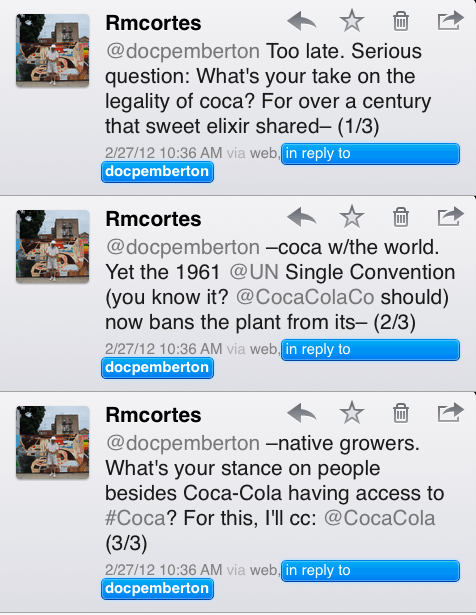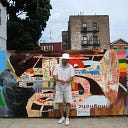
I Wasn’t the First Person to Find the NJ Cocaine Factory
Part Three: “Less Publicity of Articles About Coca Leaves and Narcotic Drugs Will Be Better For The Public”
see Part 1: The Cocainemaker, Reefer Madness, and the Vice-President of The Coca-Cola Company and Part 2: How Coca-Cola Changed the World for Coca
Among other things, my book A Secret History of Coffee, Coca & Cola is about the Coca-Cola beverage and the coca leaf of South America. Chewed for thousands of years, coca is also the plant source of cocaine and has been banned around the globe since 1961. Over the past century, The Coca-Cola Company has nevertheless imported thousands of tons of coca for its secret formula, through a special arrangement with the US government.
For my research I called upon The Coca-Cola Company and the New Jersey company it uses to process coca (originally called Maywood Chemical Works, the company was bought by Stepan Chemical in 1959), and was always rebuffed in my attempts to discuss the prohibited leaf.
It was through searches of the US National Archives where I found decades of correspondence documenting their collusion.
Amusingly, I also found an earlier attempt to investigate this history by Victor Wolfgang von Hagen, an American explorer known for his travels throughout South America in the 1940s.
Here are photographs of the letters of von Hagen, probing Coca-Cola’s trade in coca leaf and facing a familiar obfuscation.

On February 25, 1949 Victor von Hagen wrote a query to the Federal Bureau of Narcotics (FBN) under the auspices of an article about coca for a national magazine. In the letter, von Hagen is modest in his effort (“I am anxious to avoid errors…”) to procure confirmation of a long-rumored practice of The Coca-Cola Company: importing coca leaves from Peru and Bolivia.
The letter’s intended recipient was FBN commissioner Harry J. Anslinger, best known today for his successful campaign to criminalize marijuana — a crusade that was steeped in racial fear-mongering; linking pot with insanity, rape, and murder. By 1949, Anslinger had begun decade-long relationships with Maywood Chemical Works executives and The Coca-Cola Company, primarily through its Vice President, Ralph Hayes. The team worked together on business, strategy, and legal issues regarding coca leaf and processing it for Coca-Cola’s purposes.
In July, von Hagen wrote to Maywood Chemical, with inquiries to its coca importation and processing practices.

Perhaps in an effort to avoid a likely conversation-stopper, von Hagen did not mention his knowledge of the company’s relationship with the Coca-Cola beverage. Instead, he emphasized the botanical, anthropological, and historical significance of coca leaf.
Von Hagen requested Maywood’s cooperation in providing data on its annual coca imports, along with photographs and details of the subsequent cocaine extraction process. He added that the piece he was writing was intended for publication in LIFE magazine.
Maywood Chemical’s President M. J. Hartung immediately wrote commissioner Anslinger about von Hagen’s interest in its coca business for LIFE. Hartung noted his opposition to the scrutiny, writing “we do not desire the publicity which such an article might bring us.”

Commissioner Anslinger responded to Hartung’s letter with a note to Ralph Hayes, Vice President of The Coca-Cola Company, voicing displeasure with LIFE magazine and saying, “I agree with you that these articles serve no purpose except to do harm.”
Hayes wrote back promptly…

Hayes, founding director of the New York Community Trust, former aide to the US Secretary of War, and a master of diplomacy, was not lacking in personal connections. Hayes suggested he might be able to reach out to editors at the magazine; which he did…

“…our feeling has been that his projected article on coca and cocaine is an enterprise of dubious advisability… and in saying that I believe I am thinking of the public interest rather than any lesser ones.”
Anslinger concurred with Hayes in a follow-up letter to the same editor, discouraging publication of any article about coca.

However, Victor von Hagen had not received a commission from LIFE magazine to report his story.

Hayes forwarded the news back to Anslinger.
There would be no forthcoming news piece on coca in LIFE magazine.

I was amused by the episode, and I understood von Hagen’s subterfuge in the face of an extremely secretive opponent of discussion. After no responses to several calls and emails, I traveled to Maywood, NJ to speak with Stepan Company about its coca business. I never got past a secretary. After one visit, I visited the Maywood Police Department and spoke with Captain James Cullinane. At the time, I was researching a possible feature for WIRED magazine, and it was likely that professional imprimatur was what secured a meeting with him in the first place. Cullinane confirmed Stepan’s import of coca and the manufacture of cocaine, but suggested the company would not be happy with an article in a national magazine. Of course, I also contacted The Coca-Cola Company, initially under the auspices of writing my WIRED article about the unique flavor profile of Coke. That got me into a jovial conversation with Kenth Kaerhoeg, Group Director of Worldwide Public Affairs & Communications for The Coca-Cola Company. We spoke about our affinity to the delicious drink, but the conversation turned at the mention of coca leaf in the celebrated recipe. “This is how we respond to all questions relating to the formula: ‘As much as I would like to answer this specific inquiry, I am not able to comment on matters relating to the formula, which is one of our most valuable assets.’” He repeated that quote upon further inquiry.
In Feburary 1950, Scientific Monthly published “The Strange Case of the Coca Leaf” co-written by Victor von Hagen. In a letter to Hayes, Anslinger wrote “Apparently this is the story he was trying to sell to LIFE…”
“The Strange Case of the Coca Leaf” is a rich ethnography of the Andean people and their use of coca. It holds some unfortunate, antiquated observations (coca chewing is loosely associated to dwarfism and emotional dullness; its users are characterized as being “mistrustful”). However, there is no mention of Maywood Chemical Works, The Coca-Cola Company, nor anything having to do with it importing tons of coca leaf for the flagship beverage, Coca-Cola.
In July 1950, The Bureau of Narcotics filed two internal notes regarding publicity of articles about coca leaf…


Today, The Coca-Cola Company runs a robust but selectively opaque public relations machine, across social media, including several twitter accounts. One such account is a tongue-in-cheek @docpemberton representing the inventor of Coca-Cola, Dr. John Pemberton.
I asked Doc about the Single Convention treaty that allows The Coca-Cola Company access to coca leaf, while prohibiting the plants native users from traditional use. After some initial flirting, Coca-Cola went hush…




Interestingly, the full background image for the @docpemberton account was an old Coca-Cola ad with text blacked out…

But look at the original ad, uncensored, where it’s possible to read the hidden words (bold): This “INTELLECTUAL BEVERAGE” and TEMPERANCE DRINK contains the valuable TONIC and NERVE STIM-ULANT properties of the Coca plant and Cola (or Kola) nuts…

UPDATE: After I posted this screenshot, Coca-Cola switched the background image to something much more bland…

For further reading on the subject, see:
Part One: The Cocainemaker, Reefer Madness, and the Vice-President of The Coca-Cola Company
and
Part Two: How Coca-Cola Changed the World for Coca.
Or buy the book







